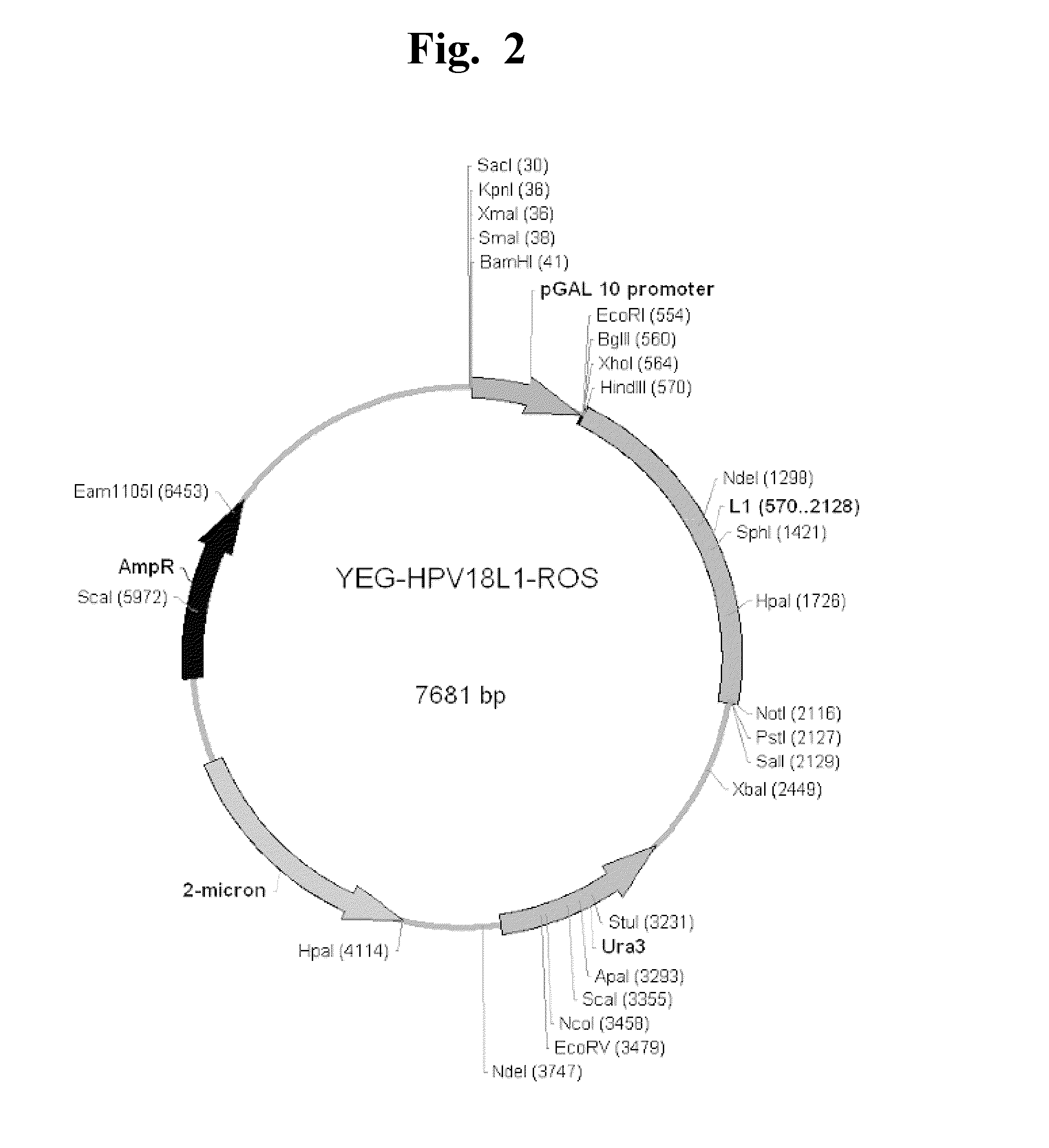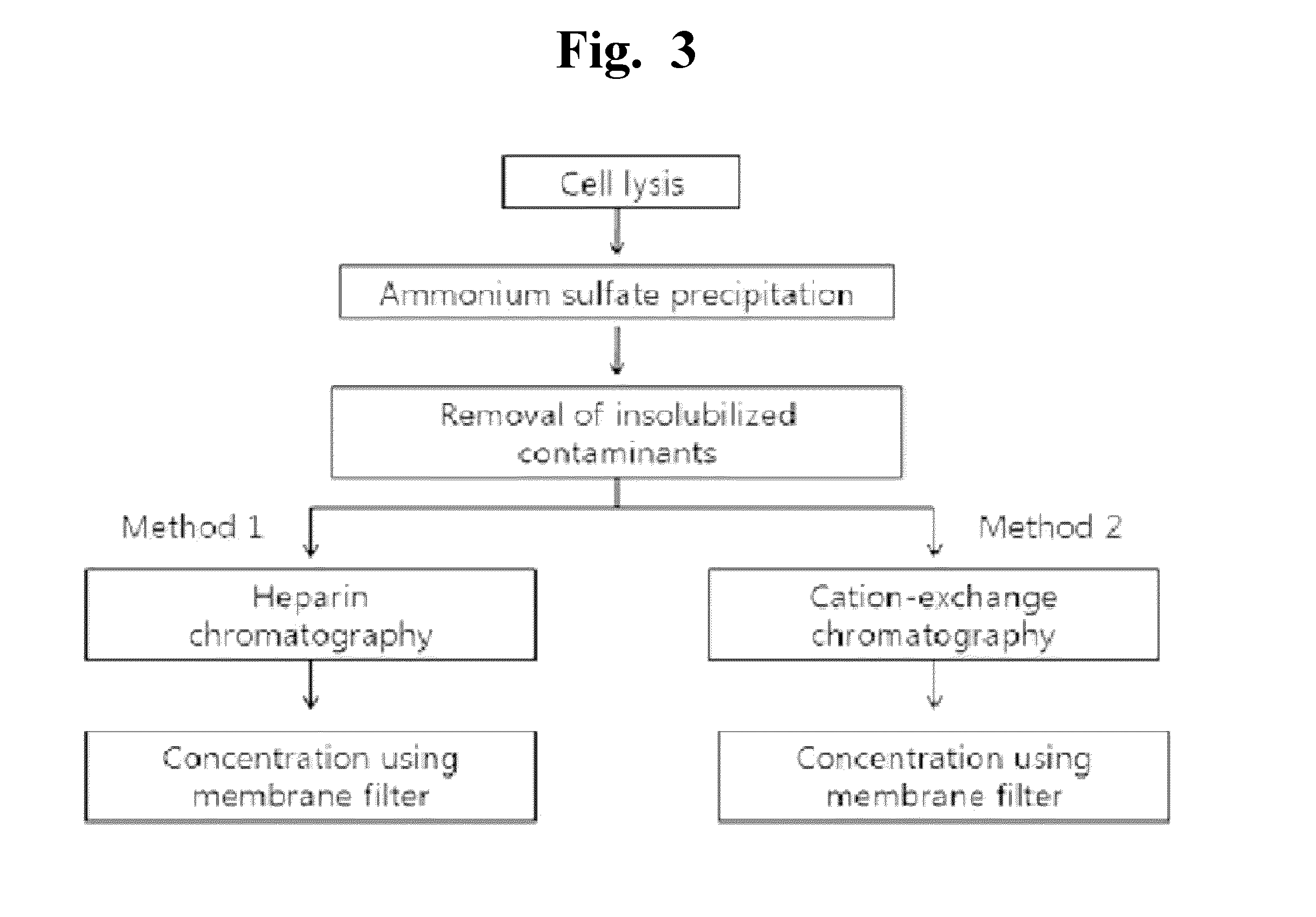Vaccine for Cervical Cancer
a technology for cervical cancer and composition, which is applied in the direction of dsdna viruses, immunological disorders, antibody medical ingredients, etc., can solve the problems of low efficacy, limited use of gardasil, and inability to use bacterial dna as an anti-cancer agen
- Summary
- Abstract
- Description
- Claims
- Application Information
AI Technical Summary
Benefits of technology
Problems solved by technology
Method used
Image
Examples
example 1
Protein Expression and Purification of Human Papillomavirus Type 16 and 18 VLP L1
Construction of Recombinant Yeast Expression System Producing HPV Type 16 and 18 L1 Protein
[0110]Using the yeast (Saccharomyces cerevisiae) optimal codon / expression, sequence 1 was selected from the sequence list for HPV type 16 L1 DNA and sequence 3 was selected from the sequence list for HPV type 18 L1 DNA. DNA were synthesized using the “Synthesis in BHB Standard Vectors” service (www.blueheronbio.com) (c.f., sequence 1 and sequence 3 from the sequence list). HindIII (AAGCTT) and ClaI (ATCGAT) restriction sites were ligated at both ends of the optimized DNA sequences. The yeast expression vectors, YEG α-HPV16L1 and YEG α-HPV 18L1, for expressing recombinant HPV16L1 and HPV18L1 proteins were constructed by DNA cloning (FIG. 1). Followings are the cloning methods: pUCminusMCS vector (Invitrogen) encoding HPV type 16 L1 DNA (sequence 1, sequence list) or HPV Type 18 L1 DNA (Sequence 3, sequence list) an...
example 2
Manufacturing a Very Short Lipopolysaccharide (LPS) Adjuvant CIA05
[0136]The inventors screened a strain (E. coli EG0021) having a very short sugar chain of lipopolysaccharide from Escherichia coli living in the bowls of healthy humans and deposited the strain E. coli EG0021 to the Korean Culture Center of Microorganisms (KCCM) on May 2, 2002, its accession number KCCM 10374 (c.f., Republic of Korea Pat. No. 0456681; WO 2004 / 039413; Korean Pat. No. 0740237; WO 2006 / 121232). Purification of LPS from this strain was done according to the methods disclosed in Korean Pat. No. 0456681; WO 2004 / 039413; Korean Pat. No. 0740237; and WO 2006 / 121232. The molecular weight of the LPS was 3,500 Da estimated by MALDI-MASS (Shimadz, Axima-LNR V 2.3.5 (Mode Liner, Power: 106)). The toxicity of the purified LPS was removed by following the protocols disclosed in Korean Pat. No. 0456681; WO 2004 / 039413; Korean Pat. No. 0740237; and WO 2006 / 121232. The purified E. coil lipopolysaccharide was adjusted t...
example 3
Comparing the Toxicity of the Novel Adjuvant CIA05 with Conventional Adjuvant MPL
[0137]The novel adjuvant CIA05 developed in this invention to be used for vaccinating cervical cancer were compared with the conventional MPL (Monophosphoryl lipid A) for its toxicity. Human PBMC (Peripheral Blood Mononuclear Cell) from healthy males donors were seeded at 5×105 cell / ml in a 24-well tissue culture plate. One ml of the growth medium, RPMI 1640+10% FBS was added to each well. The mixture was treated with 1) negative control: BSS (Balanced salt solution) 100 μl; 2) deacylated non-toxic LOS (CIA05) 10 ug / 100 ul; 3) MPL (E. coli F583 MPL) 10 ug / 100 ul. The treated medium were pooled after 12 hrs, centrifuged and the level of TNF-α secreted by THP-1 (Acute monocytic leukemia) was quantified using ELISA kit (R&D system, DY210). As shown in FIG. 22, CIA05 showed ⅓ lesser toxicity compared to the conventional adjuvant, MPL.
PUM
| Property | Measurement | Unit |
|---|---|---|
| Mass | aaaaa | aaaaa |
| Mass | aaaaa | aaaaa |
| Molar density | aaaaa | aaaaa |
Abstract
Description
Claims
Application Information
 Login to View More
Login to View More - R&D
- Intellectual Property
- Life Sciences
- Materials
- Tech Scout
- Unparalleled Data Quality
- Higher Quality Content
- 60% Fewer Hallucinations
Browse by: Latest US Patents, China's latest patents, Technical Efficacy Thesaurus, Application Domain, Technology Topic, Popular Technical Reports.
© 2025 PatSnap. All rights reserved.Legal|Privacy policy|Modern Slavery Act Transparency Statement|Sitemap|About US| Contact US: help@patsnap.com



